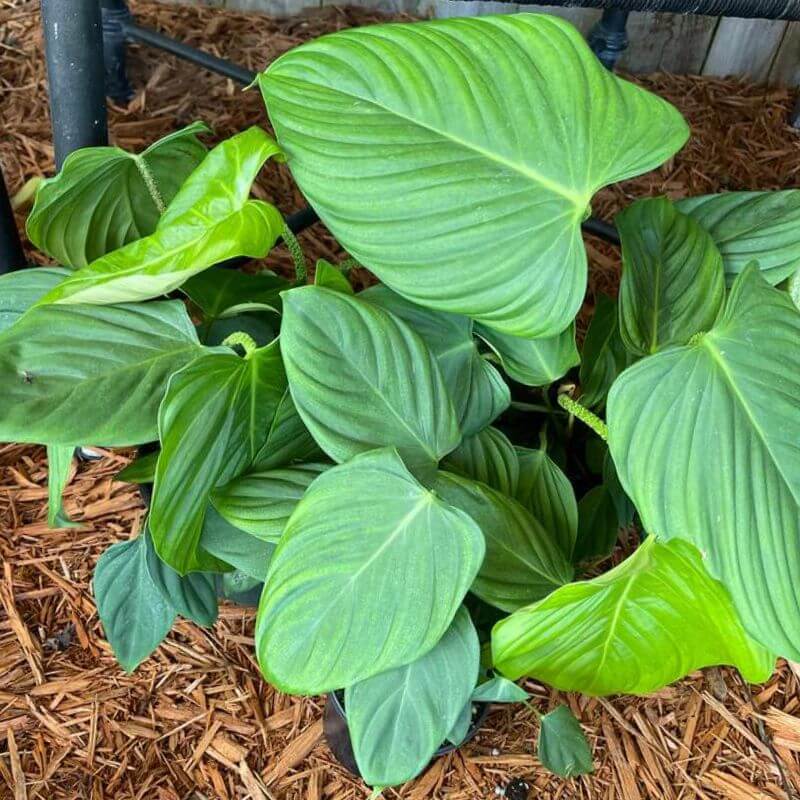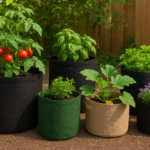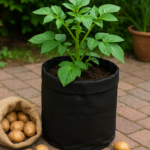Explore Philodendron Fuzzy Petiole, an exceptional houseplant with a fuzzy stem that adds interest to any room. This tropical plant thrives in bright light and high humidity. Learn more about how to grow and care for this stunning plant.
What Is Philodendron Fuzzy Petiole?

Philodendron Fuzzy Petiole, scientifically known as Philodendron nangaritense ‘Fuzzy Petiole’is a unique and visually striking variety of philodendrons. It belongs to the Araceae family. The distinguishing feature of this particular philodendron variety is its fuzzy or velvety petioles, which are the leaf stalks that connect the leaves to the main stem.
The Fuzzy Petiole philodendron showcases large, heart-shaped leaves with deep green in color, that add a touch of elegance and freshness to any indoor space. The leaves typically have deeply divided lobes, giving them a uniquely intricate appearance. The texture of the fuzzy petioles adds a noticeable element to the plant, making it visually appealing and enticing to touch.
Native to the tropical rainforests of South America, particularly Brazil and Paraguay, Philodendron Fuzzy Petiole has adapted to thrive in warm and humid environments. It has gained popularity as a houseplant due to its ability to tolerate varying light conditions, making it suitable for different indoor settings. While it can tolerate lower light levels, it thrives best in bright, indirect light.
Characteristics of Philodendron Fuzzy Petiole
Philodendron Fuzzy Petiole, known for its distinctive characteristics, possesses several unique features that make it a captivating plant:
Appearance
The leaves of this philodendron are heart-shaped with deep green in color making them visually charming and symbolic of love and affection. The distinct leaf shape adds a touch of elegance and grace to the plant.
The texture of the fuzzy petioles adds a noticeable element to the plant, making it visually appealing and enticing to touch.
Size
The Fuzzy Petiole Philodendron is a moderate-growing indoor vine. Leaves can grow up to 9 inches long, while vines can reach over 8 feet. Trim back to maintain fullness and lushness.
Growth Habit
Philodendron Fuzzy Petiole tends to have a compact growth habit, which makes it an ideal choice for small to medium-sized spaces.
Its ability to thrive in limited areas makes it a versatile houseplant option.
Given its vining nature, this philodendron variety has the ability to climb and cling to various supports.
It can be trained to grow on moss poles, trellises, or other supports, creating a visually striking display.
Air-Purifying Abilities
Like many other philodendron varieties, Fuzzy Petiole is an excellent air purifier. It helps to filter and cleanse the indoor air by removing toxins and impurities, promoting a healthier and more refreshing environment.
Low-Maintenance
This philodendron variety is relatively low-maintenance, requiring moderate levels of care. It can tolerate varying light conditions, but it thrives best in bright, indirect light. Additionally, it prefers well-draining soil and regular watering.
Versatile Placement
Philodendron Fuzzy Petiole can adapt to different environments and placement options. It can be placed on tabletops, shelves, or hung in a hanging basket, adding versatility to its display possibilities.
Longevity
With proper care, Philodendron Fuzzy Petiole can live for several years, becoming a long-term companion and adding beauty to your indoor space. Its longevity allows plant enthusiasts to enjoy its unique features for an extended period.
Philodendron Fuzzy Petiole Scientific Name
The scientific name of Philodendron Fuzzy Petiole is Philodendron nangaritense ‘Fuzzy Petiole’.
It is a tropical plant from the Araceae family, known for its unique and attractive foliage.
“Fuzzy Petiole” refers to the fuzzy texture found on the stems and leaf stalks of this Philodendron variety.
Quick Overview of Philodendron Fuzzy Petiole
| Common Name | Philodendron Fuzzy Petiole |
| Scientific Name | Philodendron nangaritense ‘Fuzzy Petiole’ |
| Family | Araceae |
| Origin | Americas |
| Growth Rate | Fast Grower |
| Identification | Heart-shaped leaves that are deep green color |
| Height | 8 feet height |
| Soil | Well-draining airy soil |
| Water | Allow water when the top inch of the soil feels dry to the touch |
| Temperature | 65-80F |
| Sunlight | Bright indirect sunlight |
| Toxic to Cats & Dogs | Yes |
| Toxic to Humans | Yes |
| Pests | Mealybugs, Aphids, Spider mites |
| Diseases | Root rot, Leaf Spot, Leaf Blight |
Philodendron Fuzzy Petiole Care
Taking proper care of the philodendron Fuzzy Petiole is essential to ensure its health and vitality. Here are some guidelines for its care:
Light
Philodendron Fuzzy Petiole thrives in moderate to bright indirect light. Place it near a window with filtered sunlight, or in a well-lit spot indoors. Avoid exposing it to direct sunlight, as it can scorch the leaves. If the variegation on the leaves starts to fade, it may indicate insufficient light, so consider providing it with a slightly brighter location.
Temperature
Philodendrons with fuzzy petioles prefer temperatures between 65°F and 80°F (18°C to 27°C). Avoid exposing it to sudden temperature fluctuations and drafty areas. Protect the plant from cold drafts, as exposure to cold air can cause damage to the foliage. Keep it away from heating vents or radiators, as direct heat can dry out the plant. Maintaining temperature within its preferred range helps promote healthy growth and prevents stress.
Watering
Water the Philodendron Fuzzy Petiole when the top inch (2.5 centimeters) of soil feels dry. Ensure that the pot has drainage holes to prevent waterlogging, as overly wet conditions can lead to root rot. Avoid overwatering or letting the plant sit in standing water. During winter or in low light conditions, reduce the frequency of watering.
You may also like Philodendron Lemon Lime
Humidity
Philodendron Fuzzy Petiole prefers higher humidity levels (40-50%). You can increase humidity by misting the leaves regularly or placing the plant on a tray filled with water and pebbles.
Alternatively, a humidifier can help maintain the ideal humidity for the plant.
Soil
Philodendrons with fuzzy petioles prefer well-draining soil to prevent waterlogging and root rot. A good soil mix of peat moss, perlite, and potting soil is suitable for Philodendron Fuzzy Petiole. This mixture provides adequate drainage while retaining enough moisture for the plant’s needs.
Avoid using heavy soils that retain too much water.
Fertilization
Fertilize your Philodendron during the growing season, which is typically spring and summer. Use a balanced, water-soluble houseplant fertilizer and follow the instructions on the package for the recommended dosage. Avoid over-fertilization, as it can lead to salt buildup and damage to the plant.
Drainage: Essential for Healthy Roots
Proper drainage is essential for the healthier and bushier growth of your plant.
Ensure that your chosen pot has drainage holes at the bottom to allow excess water to pass away.
Placing a layer of pebbles or broken pottery shards at the bottom of the pot can enhance drainage by preventing the soil from blocking the drainage holes.
Repotting Philodendron Fuzzy Petiole
Repotting becomes necessary when your Philodendron outgrows its current pot or the soil becomes compacted. When repotting, follow these steps:
- Choose a new pot that is one size larger than the current pot, allowing for sufficient room for root growth.
- Gently remove the plant from its current pot, being careful not to damage the roots. If the roots are tightly packed, you can gently loosen them to encourage outward growth.
- Place fresh soil in the new pot and create a small mound in the center. Position the Philodendron on top of the mound, spreading the roots outward.
- Fill the remaining space with soil, ensuring that the plant is at the same level as before. Lightly press the soil around the plant to secure it.
- Water the newly repotted Philodendron thoroughly to settle the soil and promote root establishment.
Remember to monitor the plant closely after repotting to ensure it adapts well to its new container. Adjust your watering routine as needed, and provide appropriate care based on the specific requirements of your Philodendron with fuzzy petioles.
Pruning
Regular pruning helps maintain the appearance and health of your Philodendron Fuzzy Petiole. Remove any yellowing or damaged leaves promptly to encourage new growth. Trimming back leggy vines also promotes bushier growth.
Use clean, sharp pruning shears or scissors to make clean cuts just above a leaf node. Pruning can be done throughout the year as needed. Always sanitize your pruning tools before use to prevent the spread of diseases.
Philodendron Fuzzy Petiole Propagation
Propagating Philodendron Fuzzy Petioles can be an exciting way to expand your plant collection or share the beauty of these unique plants with others.
There are a few methods you can use to propagate Philodendron Fuzzy Petioles.
Here are some common techniques:
Stem Cutting Propagation
- Select a healthy stem from the parent plant that has at least two to three nodes (points where leaves emerge).
- Using clean and sharp pruners or scissors, make a clean cut just below a node leaving one or two leaves at the top.
- If desired, you can apply a rooting hormone to the cut end to promote root development (optional).
- Place the cutting in a container filled with a well-draining propagation mix, such as a combination of peat moss and perlite.
- Keep the soil consistently moist but not waterlogged and provide bright, indirect light.
- After a few weeks, you should start to see new roots forming.
- Once the roots are well-developed, you can transfer the cutting to a small pot with regular potting soil.
Water Propagation
- Select a healthy stem cutting, as described in the previous method.
- Fill a glass or jar with water and place the stem cutting in the water, ensuring that at least one or two nodes are submerged.
- Place the container in a location with bright, indirect light.
- Change the water every few days to prevent stagnation and the growth of harmful bacteria.
- Over time, you should see roots forming from the submerged nodes.
- Once the roots are well-established, you can transfer the cutting to a pot with well-draining soil.
Air Layering (Advanced Method)
This method is slightly more advanced but can be effective for plants with woody stems.
- Select a stem where you want to create a new plant.
- Make a small upward cut about one-third to halfway through the stem.
- Apply a rooting hormone to the exposed area (optional).
- Surround the cut area with moist sphagnum moss or a sterile rooting medium and wrap it with plastic wrap or aluminum foil to create a sealed, humid environment.
- Monitor the moisture level of the moss or rooting medium and keep it consistently moist.
- After a few weeks to a few months, you should see roots forming in the moss.
- Once the roots are well-developed, carefully cut below the rooted area and plant it in a pot with well-draining soil.
Patience is key during the propagation process, as it can take several weeks or even months for roots to form.
With proper care and attention, you can enjoy the satisfaction of propagating Philodendron Fuzzy Petioles and watching them grow into new, thriving plants.
Common Leaf Issues in Philodendron Fuzzy Petiole
Philodendron Fuzzy Petiole, like other plants, can sometimes experience leaf issues that may indicate underlying problems.
Here are some common leaf issues you may encounter with Philodendron Fuzzy Petiole and their potential causes:
Yellowing Leaves
Yellowing leaves can occur due to various reasons, including overwatering, underwatering, nutrient deficiencies, or natural aging.
Assess the plant’s watering routine and adjust accordingly, ensuring the soil is neither too dry nor waterlogged.
Consider fertilizing the plant with a balanced fertilizer to provide the necessary nutrients.
If the yellowing is limited to older leaves at the bottom of the plant, it may be a natural process as new leaves emerge.
Brown Spots or Edges:
Brown spots or edges on the leaves can be caused by inconsistent watering, underwatering, or low humidity.
Check the soil moisture regularly and water the plant when the top inch (2.5 centimeters) of soil becomes slightly dry.
Increase humidity levels by misting the leaves or using a humidifier.
Avoid using water with high salt content, as it can cause leaf burn.
Leaf Curling
Leaf curling can be a response to dry air, low humidity, or inadequate watering.
Increase humidity levels around the plant by misting the leaves or placing a tray of water nearby.
Ensure the plant receives adequate watering, allowing the soil to dry slightly between waterings.
In some cases, curling leaves can also be caused by excessively high temperatures or direct sunlight, so adjust the plant’s placement accordingly.
Leaf Spotting or Discoloration
Leaf spots can occur due to fungal or bacterial infections, as well as pest infestations.
Treat any visible pests with appropriate measures, such as insecticidal soap or natural predators.
For fungal or bacterial issues, consider using a fungicide or adjusting environmental conditions to discourage disease development.
Remove and dispose of severely affected leaves to prevent further spread.
Assess the plant’s conditions and adjust as needed, providing stable and suitable growing conditions.
Regularly inspecting your Philodendron Fuzzy Petioles leaves can help you identify and address any issues promptly.
Pests And Diseases of Philodendron Fuzzy Petiole
Philodendron Fuzzy Petiole is generally a resilient plant, but like any other houseplant, it can be susceptible to certain pests and diseases.
Here are some common pests and diseases that may affect Philodendron Fuzzy Petiole and how to deal with them:
Pests
Aphids
Aphids are small, soft-bodied insects that can gather new growth, causing curling and distortion. They can be found clustered on new growth, undersides of leaves, or along stems.
Use a strong stream of water to wash off aphids from the plant. Alternatively, you can apply insecticidal soap or neem oil following the product instructions. Repeat treatments may be necessary to fully eliminate the infestation.
Spider Mites
Spider mites are tiny pests that can cause webbing on the leaves and damage the plant by piercing the cells and sucking out the sap.
Regularly misting the leaves to increase humidity can help deter spider mites. If an infestation occurs, you can use insecticidal soap, neem oil, or horticultural oil following the product instructions. Ensure thorough coverage, targeting the undersides of leaves.
Mealybugs
Mealybugs are small, cotton-like insects that gather in clusters. They can be found on leaf joints, leaf undersides, and along stems. Infested areas may appear white or have a sticky residue.
Remove mealybugs manually using a cotton swab dipped in rubbing alcohol or soapy water. For severe infestations, you can use insecticidal soap or neem oil following the product instructions.
Diseases
Leaf Spot
Leaf spot diseases are fungal or bacterial infections that cause spots or lesions on the leaves. The areas may vary in color, including brown, black, or yellow, and can sometimes have a concentric ring pattern.
Remove and destroy any infected leaves to prevent the spread of the disease. Ensure proper air circulation and avoid over-watering to minimize moisture on the foliage. Applying a fungicide or bactericide following the product instructions can help manage severe cases.
Root Rot
Root rot is caused by overwatering or poorly draining soil, leading to the decay of the plant’s roots. Symptoms include wilting, yellowing leaves, and a foul odor from the soil.
Address root rot by improving drainage conditions. Allow the soil to dry slightly between waterings and ensure the pot has adequate drainage holes. Trim any affected roots and repot the plant using fresh, well-draining soil.
Leaf Blight
Leaf blight is a fungal disease that causes large brown or black spots on the leaves. Remove affected leaves and ensure proper air circulation and soil drainage. Apply a fungicide if the blight persists.
By staying vigilant and taking prompt action when necessary, you can effectively manage and mitigate pest and disease issues in your beloved Philodendron Fuzzy Petiole, ensuring its continued health and vibrancy.
Philodendron Fuzzy Petiole VS Nagaritense
Philodendron Fuzzy Petiole and Philodendron nagaritense are two distinct species within the Philodendron genus. Here are some key differences between them:
Leaf Appearance
Philodendron Fuzzy Petiole: This species is known for its unique foliage. The leaves of Philodendron Fuzzy Petiole have a velvety texture and are covered with soft, hair-like projections, giving them a fuzzy appearance. The leaves are heart-shaped and can grow quite large.
Philodendron nagaritense: The leaves of Philodendron nagaritense are lance-shaped and have a glossy texture. They do not possess the fuzzy petioles or velvety hairs found on Philodendron Fuzzy Petiole.
Growth Habit
Philodendron Fuzzy Petiole: This species has a climbing growth habit and tends to produce long, trailing vines. It can be trained to climb up support or allowed to cascade down from hanging baskets.
Philodendron nagaritense: While it can exhibit some climbing tendencies, Philodendron nagaritense generally has a more upright growth habit. It may develop a more bushy appearance with multiple stems branching out from the base.
Care Requirements
Both Philodendron Fuzzy Petiole and Philodendron nagaritense have similar care requirements. They thrive in well-draining potting soil and prefer moderate to bright indirect light. They can tolerate shade but may lose variegation in lower light conditions. Water the plants when the top inch of soil is dry, avoiding overwatering. Additionally, they benefit from occasional misting to increase humidity levels.
Which One Is Better?
When deciding between Philodendron Fuzzy Petiole and Philodendron nagaritense, consider your preference for leaf appearance, growth habits, and care requirements. Both cultivars offer unique visual features that can enhance any indoor plant collection.
Is Philodendron fuzzy petiole toxic?
As for toxicity, Philodendrons, including fuzzy petiole varieties, contain calcium oxalate crystals, which can cause irritation if ingested. Keep them away from children and pets.
Where to Buy Philodendron Fuzzy Petiole
If you want to buy Philodendron Fuzzy Petiole, you can purchase it both online and offline. Here several options are available to you:
Local Plant Nurseries
Visit your local plant nurseries or garden centers. They may have Philodendron Fuzzy Petiole in stock or be able to order it for you.
Online Plant Retailers
Explore online plant retailers that specialize in rare and exotic plants. Websites like Etsy, Amazon, eBay, and specialized plant shops often offer a variety of Philodendron Fuzzy Petiole plants for purchase.
Remember to read reviews, check seller ratings, and ensure that the plants are sourced ethically and shipped with care. Always choose reputable sellers to ensure the quality and health of your Philodendron Fuzzy Petiole plant.
FAQs
How do you care for a fuzzy petiole Philodendron?
To care for a fuzzy petiole Philodendron, provide it with bright, indirect light, well-draining soil, and regular watering. Maintain a temperature range of 60-80°F (15-27°C) and higher humidity levels. Fertilize the plant every few months and prune as needed to maintain its shape.
Is Philodendron fuzzy petiole a climber or crawler?
Philodendron fuzzy petiole is primarily a climber. It produces long, trailing vines that can be trained to climb up supports or allowed to cascade down from hanging baskets. Its climbing nature makes it a popular choice for adding vertical interest to indoor spaces.
Is fuzzy petiole rare?
Fuzzy petiole Philodendrons are relatively rare compared to more common Philodendron varieties. Their unique foliage and velvety appearance make them highly sought after by plant enthusiasts. However, their availability may vary depending on local nurseries or online sellers.
Is fuzzy petiole a hybrid?
The term “fuzzy petiole” refers to a characteristic of certain Philodendron plants rather than a specific species or hybrid.
How big does a fuzzy petiole get?
The size of a fuzzy petiole Philodendron depends on the specific variety, but they can grow to several feet in length.
Conclusion
In conclusion, the Philodendron fuzzy petiole is a captivating plant with its unique velvety foliage and soft, hair-like projections. It adds an element of texture and visual interest to any indoor space. With proper care, including bright indirect light, well-draining soil, and regular watering, this Philodendron can thrive and flourish. Its climbing nature allows for creative displays and the opportunity to train it to climb supports or trails gracefully from hanging baskets. While relatively rare, the beauty and allure of the fuzzy petiole Philodendron make it a prized addition to any plant collection.
Other Philodendron Varieties







